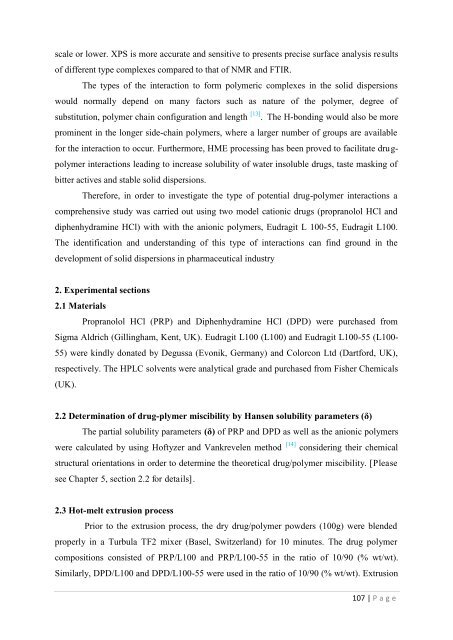Development of hot-melt extrusion as a novel technique for the ...
Development of hot-melt extrusion as a novel technique for the ...
Development of hot-melt extrusion as a novel technique for the ...
Create successful ePaper yourself
Turn your PDF publications into a flip-book with our unique Google optimized e-Paper software.
scale or lower. XPS is more accurate and sensitive to presents precise surface analysis results<strong>of</strong> different type complexes compared to that <strong>of</strong> NMR and FTIR.The types <strong>of</strong> <strong>the</strong> interaction to <strong>for</strong>m polymeric complexes in <strong>the</strong> solid dispersionswould normally depend on many factors such <strong>as</strong> nature <strong>of</strong> <strong>the</strong> polymer, degree <strong>of</strong>substitution, polymer chain configuration and length [13] . The H-bonding would also be moreprominent in <strong>the</strong> longer side-chain polymers, where a larger number <strong>of</strong> groups are available<strong>for</strong> <strong>the</strong> interaction to occur. Fur<strong>the</strong>rmore, HME processing h<strong>as</strong> been proved to facilitate drugpolymerinteractions leading to incre<strong>as</strong>e solubility <strong>of</strong> water insoluble drugs, t<strong>as</strong>te m<strong>as</strong>king <strong>of</strong>bitter actives and stable solid dispersions.There<strong>for</strong>e, in order to investigate <strong>the</strong> type <strong>of</strong> potential drug-polymer interactions acomprehensive study w<strong>as</strong> carried out using two model cationic drugs (propranolol HCl anddiphenhydramine HCl) with with <strong>the</strong> anionic polymers, Eudragit L 100-55, Eudragit L100.The identification and understanding <strong>of</strong> this type <strong>of</strong> interactions can find ground in <strong>the</strong>development <strong>of</strong> solid dispersions in pharmaceutical industry2. Experimental sections2.1 MaterialsPropranolol HCl (PRP) and Diphenhydramine HCl (DPD) were purch<strong>as</strong>ed fromSigma Aldrich (Gillingham, Kent, UK). Eudragit L100 (L100) and Eudragit L100-55 (L100-55) were kindly donated by Degussa (Evonik, Germany) and Colorcon Ltd (Dart<strong>for</strong>d, UK),respectively. The HPLC solvents were analytical grade and purch<strong>as</strong>ed from Fisher Chemicals(UK).2.2 Determination <strong>of</strong> drug-plymer miscibility by Hansen solubility parameters ()The partial solubility parameters () <strong>of</strong> PRP and DPD <strong>as</strong> well <strong>as</strong> <strong>the</strong> anionic polymerswere calculated by using H<strong>of</strong>tyzer and Vankrevelen method [14] considering <strong>the</strong>ir chemicalstructural orientations in order to determine <strong>the</strong> <strong>the</strong>oretical drug/polymer miscibility. [Ple<strong>as</strong>esee Chapter 5, section 2.2 <strong>for</strong> details].2.3 Hot-<strong>melt</strong> <strong>extrusion</strong> processPrior to <strong>the</strong> <strong>extrusion</strong> process, <strong>the</strong> dry drug/polymer powders (100g) were blendedproperly in a Turbula TF2 mixer (B<strong>as</strong>el, Switzerland) <strong>for</strong> 10 minutes. The drug polymercompositions consisted <strong>of</strong> PRP/L100 and PRP/L100-55 in <strong>the</strong> ratio <strong>of</strong> 10/90 (% wt/wt).Similarly, DPD/L100 and DPD/L100-55 were used in <strong>the</strong> ratio <strong>of</strong> 10/90 (% wt/wt). Extrusion107 | P a g e
















